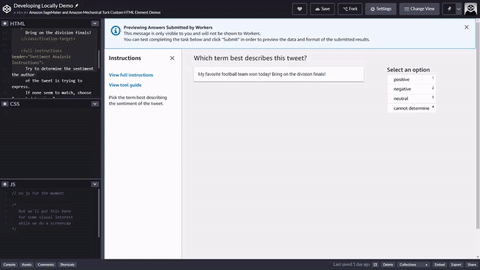本文属于机器翻译版本。若本译文内容与英语原文存在差异,则一律以英文原文为准。
简单任务示例
以下示例显示了如何为推文分析配置简单任务。所有任务都以 <crowd-form> </crowd-form> 元素开始和结束。与标准HTML<form>元素一样,所有表单代码都应介于它们之间。
对于简单的推文分析任务,请使用 <crowd-classifier> 元素。它需要以下属性:
名称 - 用于格式输出结果的变量名称。
类别-可能答案的JSON格式化数组。
标题 - 用于注释工具的标题
作为 <crowd-classifier> 元素的子元素,您必须有三个区域。
<classification-target> - 工作人员将根据在上面
categories属性中指定的选项进行分类的文本。<full-instructions> - 工具中的“查看完整说明”链接中提供的说明。这可以留空,但建议您提供适当的说明来获得更好的结果。
<short-instructions> - 对于工具栏边栏中显示的任务的更简要说明。这可以留空,但建议您提供适当的说明来获得更好的结果。
此工具的简单版本如下所示。
例 使用 crowd-classifier
<script src="https://assets.crowd.aws/crowd-html-elements.js"></script> <crowd-form> <crowd-classifier name="tweetFeeling" categories="['positive','negative','neutral', 'unclear']" header="Which term best describes this tweet?" > <classification-target> My favorite football team won today! Bring on the division finals! </classification-target> <full-instructions header="Sentiment Analysis Instructions"> Try to determine the sentiment the author of the tweet is trying to express. If none seem to match, choose "cannot determine." </full-instructions> <short-instructions> Pick the term best describing the sentiment of the tweet. </short-instructions> </crowd-classifier> </crowd-form>
您可以在 Ground Truth 标注作业创建工作流程中将代码复制并粘贴到编辑器中以预览该工具,或者试用此代码的演示 CodePen。
